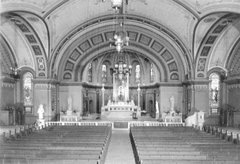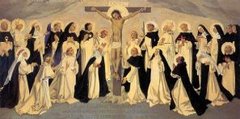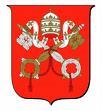"The Priest: Indispensable Vocation, Irreplaceable Gift"
Christ Speaks in the City / Special Series
Old State House, Boston, Massachusetts
12 May 2010
Fr. Romanus Cessario, O.P."The priest is everything, after God! ... Leave a parish for twenty years without a priest, and beasts will be worshiped there." These words are those of the saint whose patronage accompanies the Year for Priests. (1) He of course is John Marie Vianney, the holy Curé of Ars (1786-1859). "Leave a parish for twenty years without a priest, and beasts will be worshiped there." Were the Curé of Ars to formulate his views today, he may have been less optimistic. The Church and the world of the twenty-first century face challenges that early nineteenth-century France did not. Today, for example, John Marie Vianney would have had to envisage the widespread self-destructive behavior that consumes those who have abandoned the true worship of the living God. In post-revolutionary France, Catholic priests continued to encounter political opposition. (2) Their place however within the ecclesial communion remained secure. Today Catholic priests not only must withstand an adversarial culture and political order, but they also must deal with opposition from within the Church. Many of our Catholic contemporaries, for reasons diverse and multiple, remain uninformed about the full truth of the Catholic priesthood and the men who, for no merits of their own, actualize it.
***
We find ourselves moving toward the conclusion of the Year for Priests. Throughout this year, we have pondered a longstanding tradition within the Church: to regard the priest as representing personally Jesus Christ. So strong does this representation remain that the Catholic tradition does not hesitate to announce that the priest is another Christ. Why may the Catholic priest be called another Christ-alter Christus? The answer is simple: To emphasize the central place that Christ holds in human history. Here is how Pope Benedict XVI explains the mystery:
As an alter Christus, the priest is profoundly united to the Word of the Father who, in becoming incarnate took the form of a servant, he became a servant (Phil 2: 5-11). The priest is a servant of Christ, in the sense that his existence, configured to Christ ontologically, acquires an essentially relational character: he is in Christ, for Christ and with Christ, at the service of humankind. Because he belongs to Christ, the priest is radically at the service of all people: he is the minister of their salvation, their happiness and their authentic liberation, developing, in this gradual assumption of Christ's will, in prayer, in "being heart to heart" with him. Therefore this is the indispensable condition for every proclamation, which entails participation in the sacramental offering of the Eucharist and docile obedience to the Church. (3)
Today the temporal structures that organize our world desperately require Christ's redemption. (4) Only Christ purifies and completes them. Thus, the fundamental importance of the Incarnation. In order to comprehend fully why the Catholic priest remains indispensable and irreplaceable, we must first recognize the indispensable place that Christ holds in human history. In a word, everything depends on the Incarnation of the Eternal Son, the Word of the Father.
While many consider our present circumstances unprecedentedly alien to Christian values, the Evangelist Luke points out a world that was completely unprepared to receive Christ. We can locate this period of world history by calculating the time when the Evangelist introduces the figure of John the Baptist, the Precursor of Christ. In fact, the Gospel of Luke (Lk 3: 1-6) identifies the actual time of John the Baptist's public appearance. To be precise, the Evangelist places his reader somewhere around the years 27 or 28 AD. That is, "In the fifteenth year of the reign of Tiberius Caesar. . ." (Lk 3: 1). Consider the world that John the Baptist meets: Tiberius was succeeded by Caligula, the figure who represents the internecine disorders that characterized the Roman political world of the first century. Then came Claudius, "I, Claudius," and after him Nero, who, mad with grossly immoral dissipation, commits suicide in Rome in 68 AD. Herod Antipas-the Herod mentioned in the aforementioned Gospel-earlier thwarted this Nero's proposal to have a statue of his deified self erected in the Temple in Jerusalem. It is into this world shaped by urbane Roman imperialism-imagine what the barbarians were doing-that God sends John the Baptist to prepare the way for the Lord. Urbane Rome with her philosophers and military strategists. Seneca the Younger (3BC-65AD) taught Nero, who later required his tutor to commit suicide for plotting to overthrow him. Into this world, the Baptist is sent to prepare the way of the Lord Jesus Christ. In other words, God knew that urbanity only reaches so far into the human heart. Something else than being urbane or cosmopolitan is required. The something else is really a Someone else. He is Christ. He is also the "other Christ," the Catholic priest. Only Christ through the ministry of priests renews and elevates human life and its temporal structures.
But not without sacrifice. There is no passage from disorder to order without the shedding of blood. Not any shedding of blood. Only loving and obedient shedding of blood. Christ's blood.
***
Christ's sacrifice on Calvary was a moment in the history of the world when God "bisected" time. God split time open, and inserted a new history. The Mass is not an optional feature for human life. Religion for the devout. We either live in the new and sanctified history that God creates in Christ or we fall out of it. When we fall out of it, we worship beasts. [I am tempted to observe on the church in the Boston area that will open its services once a month to dogs and cats.] John Marie Vianney understood that the practice of true religion remains indispensable for the human creature, not just for the Catholic. In one of her official prayers, the Church prays: "Lord, we are nothing without you. As you sustain us with your mercy, receive our prayers and offerings." (5) We do not pray, "Lord, Catholics believers are nothing without you...."
At the center of the new and sacred history and of true religion, stands the Christian priest. It is difficult to estimate the extent to which the figure of the Catholic priest has suffered erosion over the past forty years. The public disclosure of sins accounts, in my view, for little of the loss. Theological distortions have contributed to the blurring of the priest's sacramental identity and his place within the Church of Christ. What else explains Pope Benedict XVI's purpose to establish a special Year for Priests? He wants the year to help priests grow toward spiritual perfection and to "enable the faithful to appreciate more fully the great gift of grace which the priesthood is." (6) The Pope recognizes that in many parts of the world, especially in the West, the faithful do not appreciate sufficiently the "great gift of grace which the priesthood is." The failure to appreciate the ministry of priests inevitably finds it correlative expression in the compromises that people make with sin. This intuition, John Marie Vianney captures when he speaks of worshiping beasts.
History also confirms the alternative to a strong and operating Christian priesthood. Saint Peter is martyred during the persecution of Nero, who about the same time moved to place himself on the altar in Jerusalem. Nero actually establishes a pattern that repeats itself throughout the Christian era: Kill the priest, and then people can do what they want. The problem worsens when the things people want-to limit ourselves to contemporary examples-include abortion, sterilization, euthanasia, bad sex, and so forth. Nero's efforts to commit overt idolatry in Jerusalem prompted more reasonable heads to delay executing the imperial command. Today's covert idolatries proceed more or less unchallenged. Indeed, they are oftentimes abetted.
The priest who confronts these deformations of the human good is the one who fully appropriates the gifts and duties that priestly ordination imposes. The Church stipulates these munera when she instructs about the priestly office: Teaching, governing, and sanctifying. The Mass affords the priest the strength to carry out his ministry of Headship. (7) The reason the Church makes this claim flows from the special relationship that the priest enjoys to the Eucharistic sacrifice. In a word, he offers it. "Receive our prayers and offerings." In the Mass, the priest exercises in a supreme degree his sacred office. Why is the Mass indispensable and irreplaceable as an instrument of renewing and sanctifying the world? The answer lies in the special efficacy the sacramentally enacted sacrifice exercises. John Marie Vianney understood this mystery: "When men want to destroy religion," he warned, "they begin by attacking the priest, because where the priest is no more, there is no more sacrifice, and where there is no more sacrifice, there is no more religion." When true religion disappears, we are not left with a liberated humanity. That view represents the modern myth of secular philosophers. (8) When true religion disappears, we find ourselves thrown back on our own weaknesses and sins. For sin, there exists no human solution. Sin begets disorder. By definition, sinful actions fall short of the divine wisdom that governs the universe.
When there is no more sacramental sacrifice, the priest whose identity depends on sacrificing is forced willy nilly into the ranks of the professional "Do Gooders." In other words, the priest takes on the identity of one of the professions that pretend to offer secular salvation. He begins to think of himself as the religious equivalent of the counselor, of the social worker, even of the political organizer. He finds himself standing between men and men instead of occupying his rightful place between God and men. The parishioners of Ars upon seeing their new pastor on the floor before the tabernacle, remarked, "He is not like other men." There of course is nothing wrong with counseling, social work, or politics. None of these professions, however, can redeem a sinful world.
Why become a priest? The answer is simple. Because the Church and the world need priests. Priest and seminarian are obliged to take up this burden in a measure of sacred time that corresponds to God's providence for their priestly ministry. For today's seminarians as well as for those who aspire to join their ranks, this means the twenty-first century. The Year for Priests suggests that the model for the Catholic priest is not found in the anti-types of the late twentieth century, the wounded healer, the social activist, the political protester, but in the image of the saintly Curé of Ars. His dedication to catechesis, to Reconciliation, and especially to the Holy Eucharist identifies the apertures where God still "bisects" the time. Only priests instruct authentically, forgive effectively, and sacrifice pleasingly. Both priests and seminarians, affirms Pope Benedict XVI, remain indispensable and irreplaceable. The Pope learned this great mystery, one assumes, from the Curé of Ars: "Leave a parish for twenty years without a priest, and beasts will be worshiped there.
(1) See the MAGNIFICAT© Year for Priests Companion, ed. Peter John Cameron (New York: Magnificat, 2009), p. 44.
(2) I note with gratitude that the Vocation Directors of the Archdiocese of Boston, Fathers Daniel Hennessey and Michael Harrington, afford me the privilege of speaking in the historical setting of Boston's Old State House. France of course supported the independence movement of the American colonists.
(3) General Audience, Saint Peter's Square, Wednesday, 24 June 2009.
(4) St. Josemaría Escrivá adapts the expression to exhort all Christians. See his Christ is Passing By, no. 183: "We must, each of us, be alter Christus, ipse Christus: another Christ, Christ himself. Only in this way can we set about this great undertaking, this immense, unending task of sanctifying all temporal structures from within, bringing to them the leaven of Redemption."
(5) Roman Liturgy, Mass formulary for the Second Sunday of Advent: Placáre, quæsumus, Dómine, humilitátis nostræ précibus et hóstiis: et ubi nulla súppetunt suffrágia meritórum, tuis nobis succúrre præsídiis. Per Dóminum nostrum Jesum Christum Fílium tuum, qui tecum vivit et regnat in unitáte Spíritus Sancti, Deus, per ómnia sæcula sæculórum. Amen.
(6) Companion, p. 3.
(7) See Catechism of the Catholic Church, no. 1556.
(8) Companion, p. 44.
Tuesday, June 01, 2010
Year of the priest
From Friar Blog of the Eastern Province:
Subscribe to:
Post Comments (Atom)





















No comments:
Post a Comment